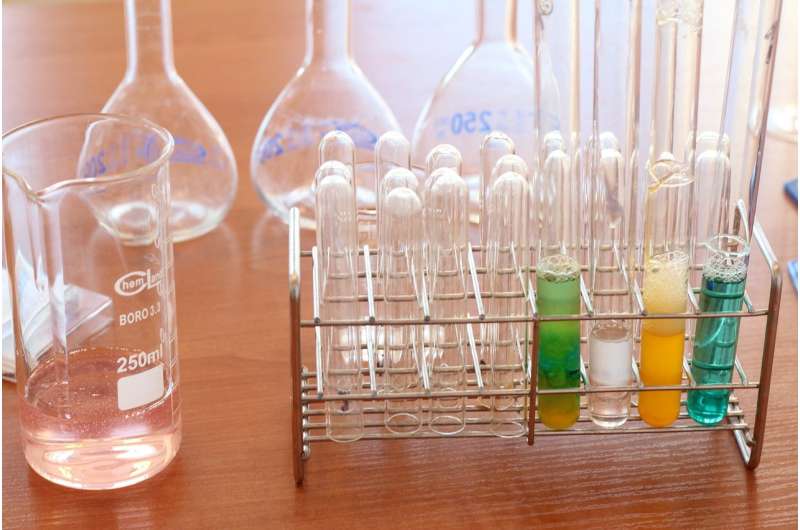Assessing a compound's activity, not just its structure, could accelerate drug discovery

Assessing a drug compound by its activity, not simply its structure, is a new approach that could speed the search for COVID-19 therapies and reveal more potential therapies for other diseases.
This action-based focus—called biological activity-based modeling (BABM)—forms the core of a new approach developed by National Center for Advancing Translational Sciences (NCATS) researchers and others. NCATS is part of the National Institutes of Health (NIH). Researchers used BABM to look for potential anti-SARS-CoV-2 agents whose actions, not their structures, are similar to those of compounds already shown to be effective.
NCATS scientists Ruili Huang, Ph.D., and Wei Zheng, Ph.D., led the research team that created the approach. Their findings were posted online Feb. 23 by the journal Nature Biotechnology.
"With this new method, you can find completely new chemical structures based on activity profiles and then develop completely new drugs," Huang explained. Thus, using information about a compound's biological activity may expand the pool of promising treatments for a wide range of diseases and conditions.
When researchers seek new compounds or look for existing drugs to repurpose against new diseases, they are increasingly using screening tools to predict which drugs might be good candidates. Virtual screening, or VS, allows scientists to use advanced computer analyses to find potentially effective candidates from among millions of compounds in collections.
Traditional VS techniques look for compounds with structures similar to those known to be effective against a particular target on a pathogen or cell, for example. Those structural similarities are then assumed to deliver similar biological activities.
With BABM, however, researchers don't need to know a compound's chemical structure, according to Huang. Instead, they use a profile of a compound's activity patterns—how it behaves at multiple concentrations against a panel of targets or tests—to predict its potential effectiveness against a new target or in a new drug assay.
The now-widespread use of quantitative high-throughput screening (qHTS) allows BABM more accuracy in its predictions. qHTS assesses a compound's effectiveness at multiple concentrations in thousands of tests over time. That practice provides far more detail about how a compound behaves than does traditional high-throughput screening, which tests only a single concentration of the compound. The information generated by qHTS creates a stronger biological activity profile—also known as a signature—for each one of millions of compounds.
To test the BABM approach, the researchers tapped the vast pool of data generated by hundreds of qHTS analyses run on NCATS' in-house collection of more than 500,000 compounds and drugs. First, they verified BABM's ability to use activity profiles to identify compounds already shown to be effective against the Zika and Ebola viruses. BABM also identified new compounds that showed promise against those viruses.
The scientists then turned to SARS-CoV-2, the virus that causes COVID-19. They applied BABM, a structure-based model and a combined approach to analyze the NCATS library's compounds to find potential anti-SARS-CoV-2 agents. BABM predicted that the activity profiles of 311 compounds might indicate promise against the coronavirus.
The researchers then had an outside laboratory test those 311 compounds against the live SARS-CoV-2 virus. The result: Nearly one-third of the BABM-backed compounds (99) showed antivirus activity in the test. The BABM-driven prediction hit rate topped that of the structure-based model—and combining the activity-based and structure-based models yielded even better predictive results.
A key advantage to BABM is speed. "This method is very fast—you essentially just run a computer algorithm, and you can identify many new drug leads, even with new chemical structures," Huang noted. In fact, screening the entire NCATS library of half a million compounds for anti-SARS-CoV-2 candidates took only a few minutes.
BABM also is a transferable tool—it's not limited to use in the NCATS compound libraries. "Anyone can use this method by applying any biological activity profile data, including publicly available NCATS data," Huang emphasized.
The NCATS researchers predict their activity-based model's impact could extend far beyond the search for COVID-19 treatments and small-molecule drug discovery. Given any substance with an available activity profile, scientists can predict its activity against a new target, for a new indication, or against a new disease.
"In addition to small molecules, this approach can be applied to biologics, antibodies, and other therapies," Huang said. "BABM is for all drug discovery projects."
More information: Ruili Huang et al, Biological activity-based modeling identifies antiviral leads against SARS-CoV-2, Nature Biotechnology (2021). DOI: 10.1038/s41587-021-00839-1
Journal information: Nature Biotechnology
Provided by National Institutes of Health





















